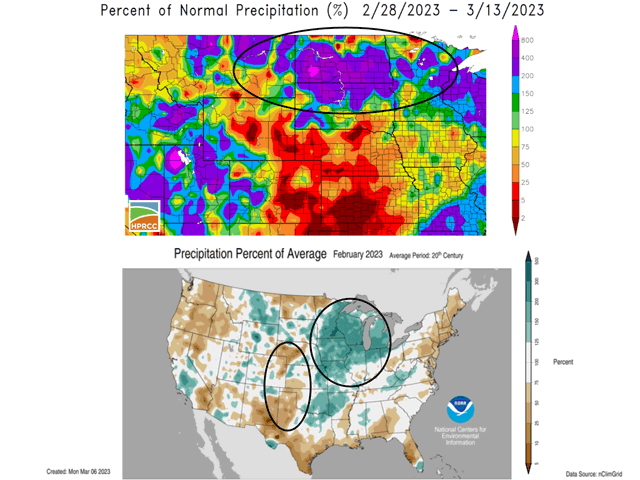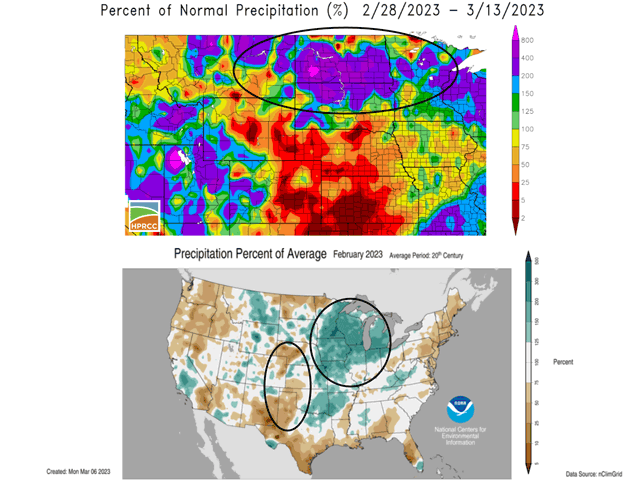Ag Weather Forum
Early Spring Features Wide Soil Moisture Swings in Primary US Crop Areas
Wide extremes from dry to wet dominate the soil moisture situation across most of the prime crop areas in the United States this early spring. This have and have-not status leads to questions about moisture availability to bring more than a fraction of the hard red winter wheat crop to fruition, while snow cover and wet soils show up from the Northern Plains to the Ohio Valley.
In the western and southwestern Plains, February precipitation amounted to no more than half the normal amount. That lack of moisture is showing up in winter wheat ratings. Latest USDA-NASS crop condition reports show the Kansas wheat crop rates 52% poor to very poor -- a historically low level at this point in the year. The Texas winter wheat crop is judged at 50% poor to very poor. And the Oklahoma winter wheat crop has a total of 44% rated poor to very poor. These low numbers directly relate to dry conditions.
Farther north and east, meanwhile, February precipitation in the Midwest was around three times the normal amount. And in the Northern Plains, the first half of March brought a similar heavy precipitation load. Snow water equivalent moisture in North Dakota is reportedly around 6 to 12 inches. March 11 brought more evidence of this pattern, with the USDA weekly weather and crop bulletin noting record-setting snowfall for the date of 9.1 inches in Grand Forks, North Dakota, and 6.4 inches in Des Moines, Iowa.
P[L1] D[0x0] M[300x250] OOP[F] ADUNIT[] T[]
Soil moisture profiles are getting a recharge in these heavy precipitation areas, but sustained wintry conditions have some weather and climate specialists looking at the potential for a late start to spring planting.
"Right now, the snow is probably not something to worry about for fieldwork. If it's still snowing heavily in April, that would be more troublesome," said Jamie Mosel, extension climate resilience educator at the Minnesota Climate Action Project. "So, we might not get an early planting season in the case of late snow plus a cold spring ... What is more worrisome when it comes to accessing fields in the spring is heavy rainfall. That has caused delays in the past, including in 2019 for example." Crop year 2019 was so delayed by wet conditions that, according to USDA meteorologist Brad Rippey, U.S. corn planting failed to reach the halfway mark by May 19 for the first time on record.
The balance of March features some easing of heavy precipitation in the Northern Plains and Midwest; however, mainly below-normal temperatures offer limited chance for notable field drying. Meanwhile, the Southern Plains has only limited precipitation in store with minimal usefulness for the developing wheat crop and questionable support for the early row crop phase when seeding gets underway.
See the Ag Weather Forum on "Snow, Severe Thunderstorms and Well-Below-Normal Temperatures This Week" for latest forecast at https://www.dtnpf.com/….
Bryce Anderson can be reached at Bryce.Anderson@dtn.com
Follow him on Twitter @BAndersonDTN
(c) Copyright 2023 DTN, LLC. All rights reserved.






Comments
To comment, please Log In or Join our Community .